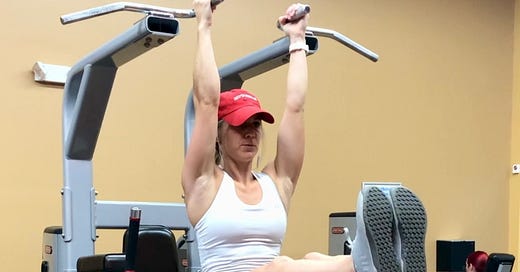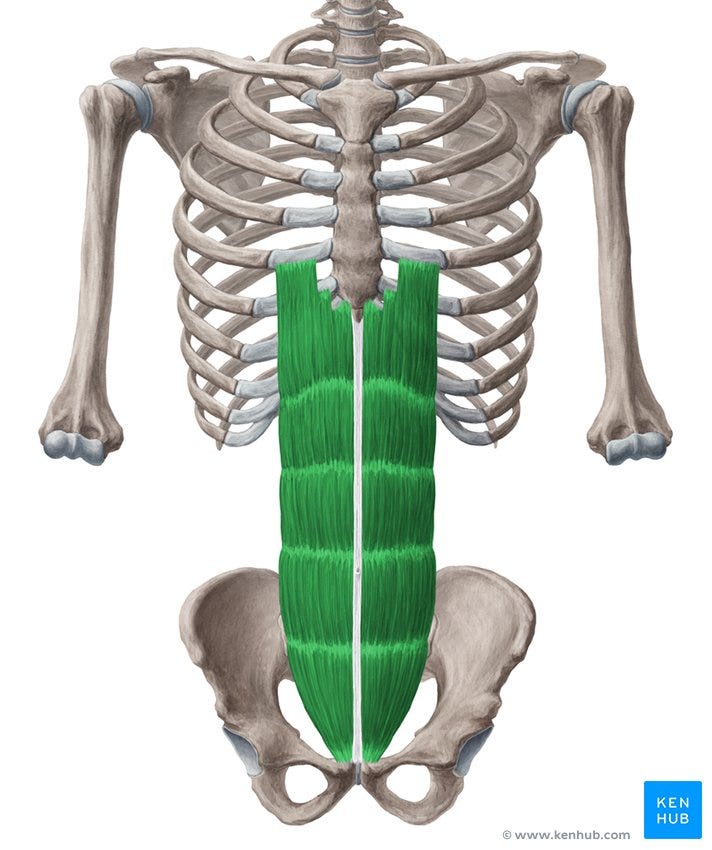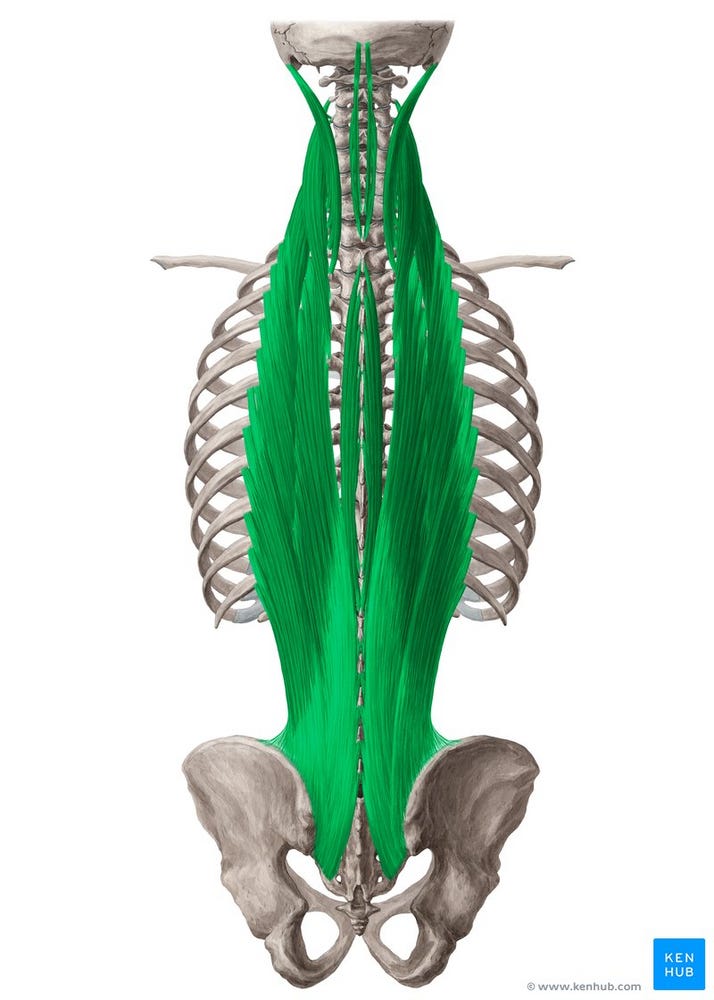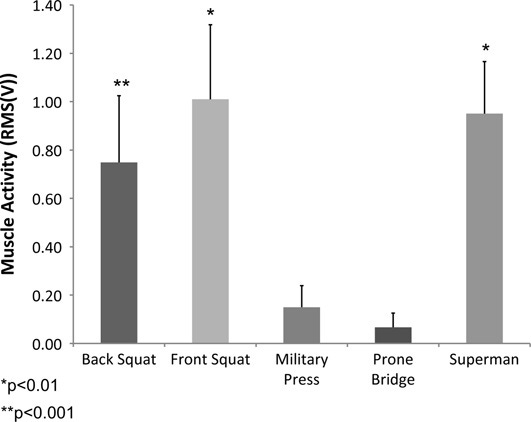In this edition of Momentum you’ll learn why you may, or may not, want to include direct core training into your program, you’ll learn the anatomy and function of the different core muscles, and you’ll get a few of my favorite direct core exercises.
Let’s start this post with a pop-quiz:
Which is true regarding the training of the core muscles (abs, obliques, lower back erectors)?
A) All you need to develop your core is squats, deadlifts, and other compound movements
B) You must do direct ab work for all the core muscles (rectus abdominis, internal/external obliques, transversus abdominis, erector spinae, QL, etc) for core development
Which did you choose?
Well, they're both wrong.
The answer to this question is the same as it is for many questions in life.
It depends. Here's why:
First and foremost, training goals dictate exercise selection. Someone’s training goals can be aesthetic related or performance oriented, or both. Further, their program and exercise selection will be influenced by their injury history, personal preferences, equipment access, and more.
The muscles of the core are just like any other muscle and respond to training similarly. Compound lifts can develop the core muscles because they are working isometrically to stabilize the trunk during heavy lifts. But, in some cases you may want to do more.
Let’s take a look at how the different muscles of the core respond to different exercises.
Core Muscle Activation During Different Exercises
THE RECTUS ABDOMINIS (RA)
This muscle gives us the much desired six-pack, if you're lean enough. If you're not lean and it doesn’t show, don't worry, its still in there. This muscle produces trunk flexion like when you do a sit-up or when you do hanging leg raises. It also works to resist extension like when you do ab wheel roll outs.
Many say that squats and deadlifts are enough to build these muscles, but our lab coat friends say otherwise. Several studies have evaluated muscle activation of the RA during compound lifts like squats and deadlifts and compared it to planks, crunches, or pikes.
RA activity was significantly higher in the prone bridge, better known as a plank, than any other movement tested.
These results were duplicated in another study that compared back squats, overhead squats, and several abdominal exercises. Here, a straight leg sit-up reigned supreme for RA activation.

*Keep in mind, the majority of this data is from EMG studies. While not perfect, EMG still seems to be the best insight we have into muscle activation from exercise. When combined with practical experience from coaches and athletes we have a good idea at what gets built from what.*
Rectus Abdominis: To Train or Not to Train?
It's pretty clear that the RA doesn’t get trained much-using compound lifts. Isolation exercises to fully develop this muscle would definitely benefit people who want stronger abs or abs that ‘pop’ more. If this aligns with your training goals think about adding in some of my favorite ab builders like hanging leg raises, weighted sit-ups, and ab wheel roll-outs.
THE ERECTOR SPINAE (ES)
The low back muscles, the erectors, are long muscles that run the length of the spine and are responsible for straightening us back up when we are bent over. This muscle gets trained significantly with compound movements like squats and deadlifts because the muscles are actually being loaded properly.
EMG activity for the low back extensors was very strong for compound exercises and isolation exercises.
Erector Spinae: To Train or Not to Train?
Compound lifts could be enough to train the low back erectors. This expands beyond just squats and deadlifts. Exercises like bent-over rows, cleans, snatches, and RDLs can also be enough to train the erectors.
But, what if your low back muscles are the only muscle that gets sore and fatigued after squats and deadlifts? What if every time you front squat your back rounds and you miss the lift because of your back and not your legs? If this is you, then training the erectors directly may be a good idea to build up the weak link in your lifts.
Try back extensions or reverse hypers to strengthen this muscle group directly. For better carry over to the compound lifts like squats and deadlifts you can try using tempo lifts where the main focus is maintaining a consistent back angle throughout the exercise and pausing during your typical sticking or failing point.
Jefferson curls are one of my favorite lower back extensor exercises. It’s one of the few exercises that places the muscle through a large range of motion and when loaded gradually does a great job of strengthening an often neglected motion.
THE OBLIQUES
The muscles on the sides of the trunk are the internal and external obliques. These muscles are responsible for dynamically producing trunk rotation, and isometrically stabilizing the trunk when forces are placed on it in the transverse or frontal plane i.e. rotation or from the sides.

Here, the side plank (SP) produced the most external oblique activity compared to any other exercise tested. This makes sense because side planks were the only exercise tested that challenges trunk stabilization in the frontal plane, where the obliques are more active.
Obliques: To Train or Not to Train?
In order to develop the obliques, I think you should add in some rotational movements and some movements that produce lateral flexion. These don't get trained too much in compound lifts because the forces on the torso are primarily in the sagittal plane. Doing single limb exercises with offset loading like split squats would require some stabilization and more activation from the obliques to maintain an upright posture throughout the lift. Isolation exercises like DB side bends, side planks, and Copenhagen lifts would do the trick for full development here.
Programming Direct Core Work
Remember, the principles of progressive overload and specificity should still apply with core training. Don't just do a few sets of planks once a week. Plan out the training like you would for any other muscle group with progressive loading and exercises to target specific tissues. This doesn't have to be complicated. Here is a sample progression for some isometric rectus abdominis work.
Week 1: 3 x 8, tempo 2-0-1
Week 2: 3 x 10, tempo 2-0-1
Week 3: 3 x 12, tempo 2-0-1
Week 4: 3 x 12, tempo 2-1*-1
*pause in the farthest reach
Core Training and Lower Back Pain
No exercise can prevent injury or pain. There are no magic bullet exercises. That said, strength training is one of the only interventions that has been shown to significantly reduce the risk of injury.
By specifically targeting the muscles around the midsection with varying stimuli you can increase your resiliency to injury by preparing to move against load and produce force in a wide variety of ways.
Strength training not only builds up the muscles but also strengths our tendons, ligaments, and spinal discs. If you have more resilient body tissues they are less likely to get injured.
References
Aspe, Rodrigo R.1; Swinton, Paul A.2 Electromyographic and Kinetic Comparison of the Back Squat and Overhead Squat, Journal of Strength and Conditioning Research: October 2014 - Volume 28 - Issue 10 - p 2827-2836 doi:10.1519/JSC.0000000000000462
Bautista, D., Durke, D., Cotter, J. A., Escobar, K. A., & Schick, E. E. (2020). A Comparison of Muscle Activation Among the Front Squat, Overhead Squat, Back Extension and Plank. International journal of exercise science, 13(1), 714–722.
Comfort, Paul; Pearson, Stephen J; Mather, David An Electromyographical Comparison of Trunk Muscle Activity During Isometric Trunk and Dynamic Strengthening Exercises, Journal of Strength and Conditioning Research: January 2011 - Volume 25 - Issue 1 - p 149-154doi: 10.1519/JSC.0b013e3181fb412f
van den Tillaar,R. & Saeterbakken,A.(2018).Comparison of Core Muscle Activation Between a Prone Bridge and 6-RM Back Squats. Journal of Human Kinetics,62(1) 43-53. https://doi.org/10.1515/hukin-2017-0176










